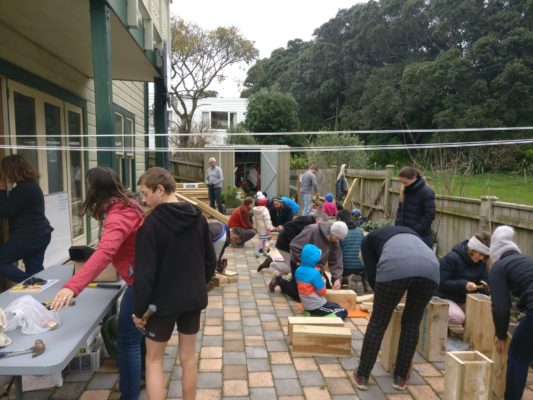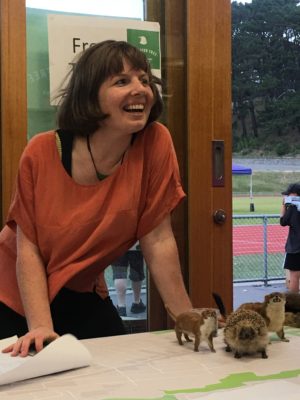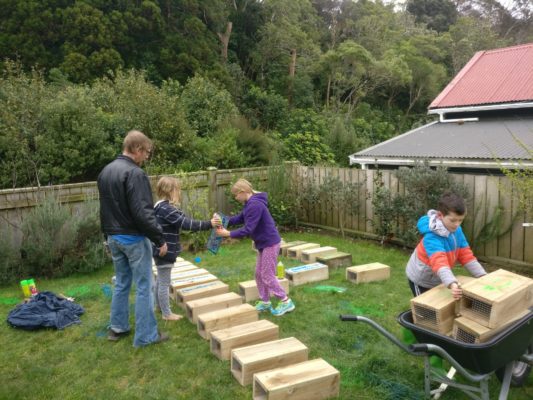Andrew Roxburgh reckons the Newtown area of Wellington where he lives is becoming a more wild place – “and that’s pretty cool!”

Andrew is a volunteer with Predator Free Mt Cook/Newtown/Berhampore and says that as birds are spreading out from Zealandia, people are becoming more aware of them. They’re noticing native birds more.
“Kaka are seen regularly and tui are in backyards everywhere. There’s a falcon in the hills behind Newtown and moreporks are seen too. A workmate said that a kaka woke him up at 4am and my neighbours have complained that they’re getting woken by tui. It’s just generally exciting!” he says. “It stops conservation being something that’s far away. It’s not separate from normal life now. Every day should be a little bit special like that.”
Andrew is in his 30s and while he and others of his age-group are excited about the changes flowing out into the city from Zealandia, for the younger generation it’s just part of how they expect things to be.
“We get mocked by our children,” he admits. “They say ‘it’s just another tui’!”
Andrew and his fellow backyard trappers are doing everything they can to make nesting outside the Zealandia sanctuary safer for the birds spreading out into their suburbs and to ensure that tui and kaka continue to be a familiar sight for neighbourhood children – and more and more of their neighbours are coming on board to help.

“We had a table at the Mt Cook Spring Fling late last year. It’s a community get-together in the local reserve with stalls and games for the kids. We’ve held sausage sizzles at the Newtown New World Supermarket and had a table at the Newtown Market. We’re trying to spread the word to the community with leaflet drops and digital adverts on Facebook as well, but what works best for us is getting in front of people with a stand with tunnels and traps.”
As Andrew and other volunteers get out and about in their community to promote the benefits of removing predators, they’ve come to realise those benefits aren’t just to native birds. Their community is benefitting too.
“It’s awesome that it’s bringing conservation and community together in different ways,” says Andrew. “One volunteer checks the trap of his elderly neighbour a couple of times per week and checks that she is okay at the same time. Working bees to make trap tunnels are a big community event and you get to know people quite well when you work together and share a cuppa. Lots of people are benefitting by getting to know their neighbours.”
Mt Cook/Newtown became a Kiwibank Predator Free Community in June 2017 and the subsidy they receive on each trap purchased has helped to ensure that no-one in their diverse community experiences any financial barrier to taking part in backyard trapping.
“We want to make sure that everyone who wants to be involved, can be. The community we’re part of is highly diverse in terms of income inequality. Thanks to Kiwibank, those who can afford it, can buy a Goodnature trap at a subsidised discount. Those in the community who are less well off are offered a Victor rat trap to take home for free. When we stop people to talk, they generally know about the predator free idea. People quickly get excited about taking a trap home.”

The team is aiming for 1 trap in every 5 backyards over their three neighbourhoods and Andrew reckons they’re currently about half way to achieving that goal of 20% of their community carrying out trapping.
“It changes daily, but at the moment we’ve got 100 traps in Mt Cook out of a total of 860 backyards – that’s 11.6%. Newtown has 136 traps (8.2%) and Berhampore, which joined fairly recently, has 47 backyard trappers (5.3%).”
Andrew is keen to keep a tally of predators caught. The officially logged stats so far are ‘tons’ of mice (552 to be exact), 291 rats and some 23 hedgehogs, but the actual numbers are likely to be higher.
“There’s strong anecdotal evidence of under-reporting. We only know what volunteers tell us, but often people will say they caught something and when you ask them, the catch hasn’t been logged.”
One day, perhaps, the predator proof fences at Zealandia will no longer be needed. In the meantime, Andrew has one key message for potential trappers in his community and others:
“Backyard trapping is only a small commitment individually – but collectively we can make a big difference.”

